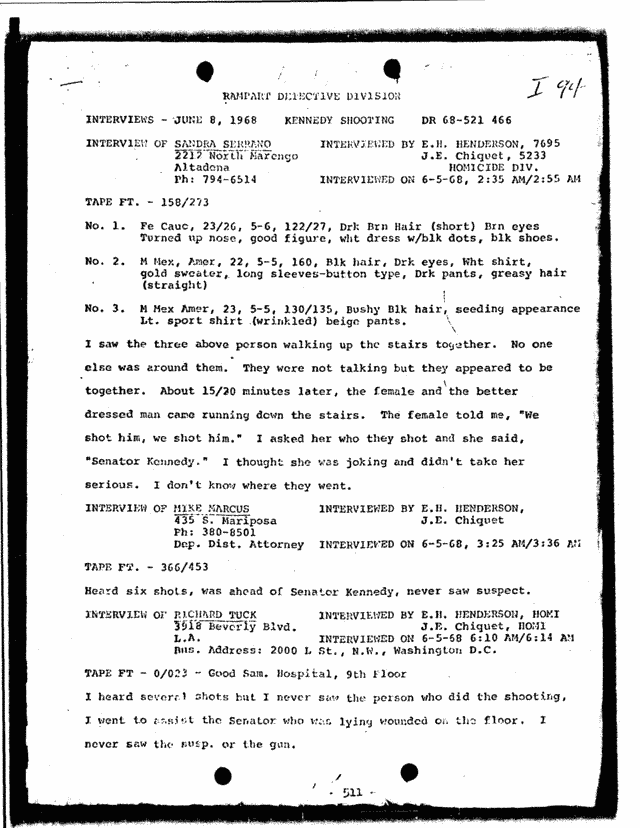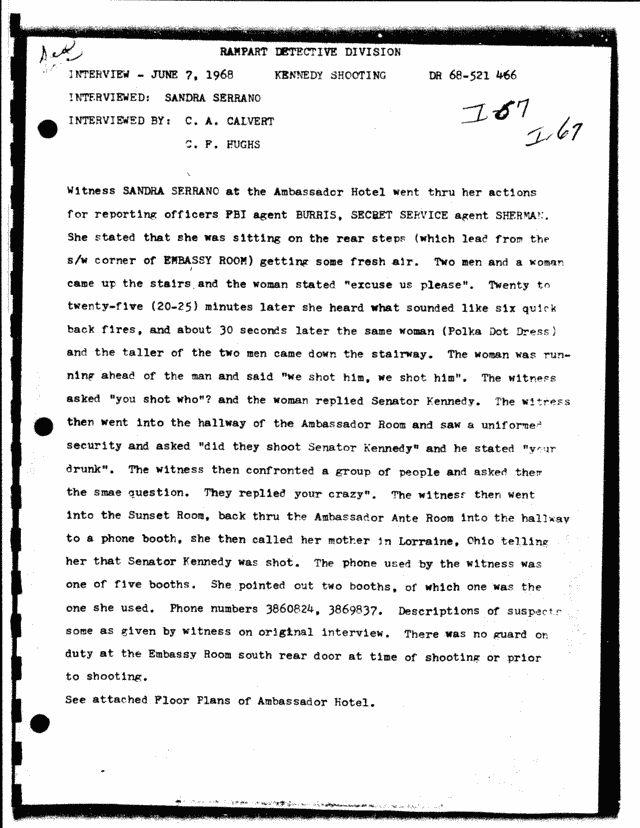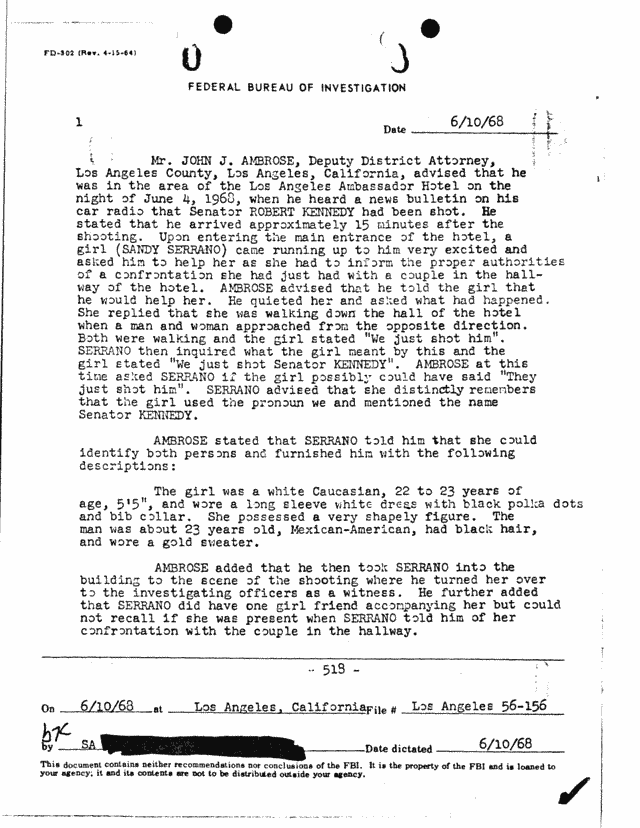The Girl In The Polygraph Test: Part One
[Original version posted on my blog on 22 February 2014 as "Part One: The Girl In The Polka Dot Dress, The Girl In The Polygraph Test"]One of the stranger aspects of the Robert F. Kennedy murder case is the extent to which a polygraph operator shaped its investigation. As seen in the previous post, Larry Arnot took the stand at Sirhan Sirhan's trial, ostensibly to establish that Sirhan had purchased .22-caliber ammunition for the pistol he used in the attack on Senator Kennedy. When asked to testify about the sale, Arnot immediately asked for clarification about whether he should relate "the whole transaction." He then proceeded to tell the truth as he knew it: three men came into the store, and one of them requested and purchased .22-caliber ammunition. At which point, the prosecutor interrupted. He reminded his witness about the interview and polygraph with LAPD Lt. Enrique Hernandez, who established that while Arnot did make such a sale to Sirhan, he had also mixed that transaction up with a separate one involving three men who came into the store together.
That was a relatively minor bump in the road in comparison with a separate issue. As previously mentioned, in the course of an interview with Jerry Owen, Lt. Hernandez shared the observation that he had talked to 23 people who said they saw a girl in a polka dot dress, and they were all lying about it. Whether or not there were that many actual witnesses (instead of him pulling something out of his butt to make a point), it appears that the issue of the alleged woman was particularly hard to deal with in setting the record straight. Two people were the main problem.
Vincent DiPierro was an Ambassador Hotel waiter who stood in line with other kitchen workers at Senator Kennedy's left as he walked through the pantry (see William Klaber and Phil Melanson's Shadow Play, pp. 139-140). DiPierro said that, after shaking hands with Kennedy, he had noticed off ahead in the distance an attractive woman very close to a man -- "almost holding him" -- who then stepped out and began firing a pistol. That man proved to be Sirhan Sirhan, but DiPierro's attention was drawn there in the first place due to the woman's apparently exceptional good looks.
The transformation of DiPierro's account can be followed by reading the notations for his interviews in "Appendix E: Robert F. Kennedy Assassination Investigation Records Audio Tapes" of the LAPD's "Special Unit Senator" (SUS) report. (Interview tapes are identified by tape number, name of the witness and their identification number, date of interview, and a brief description of the witness and the account they gave.)
Tape# CSA-K5; DiPierro, Vincent; # I-1167; June 5, 1968 (Subject: "Ambassador Hotel waiter; witness interview. Describes shooting, hearing 4-5 shots, and seeing a girl wearing a polka-dot dress next to the suspect prior to shooting.")
Tape# CSA-K4; DiPierro, Vincent; # I-1167; June 10, 1968 (Subject: "Ambassador Hotel waiter; witness interview. DiPierro reviews a variety of polka dot dresses shown to him by police. He mentions specific similarities and differences between the dresses on hand and the one he claimed was worn by 'the girl in a polka-dot dress.'")
Tape# CSA-K12; DiPierro, Vincent; #I-1167; July 1, 1968 (Subject: "Ambassador Hotel waiter; pre-polygraph examination interview. Describes arriving at the hotel, and noticing a girl in a polka-dot dress next to Sirhan in the kitchen prior to the shooting.")
Tape# CSAK122; DiPierro, Vincent; # I-1167; July 1, 1968 (Subject: "Ambassador Hotel waiter; polygraph examination. DiPierro first states that he saw a girl in a polka dot dress. When told that his exam shows that he didn't see such a girl, he recants, guessing that he made up the story after talking to Sandra Serrano.")
Tape# CSAK125; DiPierro, Vincent; # I-1167; July 1, 1968 (Subject: "Ambassador Hotel waiter; witness interview. Recants prior statements about seeing a girl in a polka dot dress.")
Taken at face value, this might seem fairly uncomplicated: DiPierro claimed something after talking to someone else; a polygraph showed he was not honest about it, so he admitted he must have made up his story. Truth wins again. But considering what happened with the main witness, an entirely different picture emerges.
Sandra Serrano was a 19-year-old "Youth for Kennedy" volunteer who had stepped out on a fire escape of the Ambassador Hotel to get some air away from the heat inside. She said that while she was there, a woman and two men came up the stairs and entered the building. According to Serrano's initial statement, the woman was a female Caucasian, 23-26 years old, 5' 6" tall, 122-127 lbs., with short dark brown hair, brown eyes, and a turned-up nose; she had a "good figure" and was wearing a white dress with black dots and black shoes. Serrano described one of the men as a male Mexican-American, 22 years old, 5' 5" tall, 160 lbs., with straight, greasy black hair and dark eyes, wearing a white shirt under a gold long-sleeved sweater, and dark pants. She described the second man as a male Mexican-American, 23 years old, 5' 5" tall, 130-135 lbs, with bushy black hair and a "seeding appearance" -- meaning "shabby," apparently (as in "gone to seed"). He wore a wrinkled light sport shirt and beige pants. Serrano gave this statement:
I saw the three above person [sic] walking up the stairs together. No one else was around them. They were not talking but they appeared to be together. About 15/20 minutes later, the female and the better dressed man came running down the stairs. The female told me, "We shot him, we shot him." I asked her who they shot and she said, "Senator Kennedy." I thought she was joking and didn't take her serious. I don't know where they went.
(Click on image or open in new tab or window to view full-size)

Klaber and Melanson related what happened after the encounter, before Serrano talked to the police.
In shock, Serrano went inside where she ran into her friend Irene Chavez. Tearful, nearly hysterical, she described her strange encounter, only to discover that Robert Kennedy had indeed been attacked. Word of the shooting had begun to spread. Soon Serrano found herself being interviewed by NBC correspondent Sander Vanocur on national television. A stunned, blurry-eyed audience heard a dramatic account given by a shaken but coherent young woman:
"This girl came running down the stairs in the back, came running down the stairs and said, 'We shot him. We shot him.' And I said, 'Who did you shoot?' and she said, 'We shot Senator Kennedy.' ... She was Caucasian. She had on a white dress with polka dots. She was light skinned, dark hair. She had on black shoes, and she had a funny nose." (Shadow Play, pp. 14-15)
....Vanocur was not the first person to whom Serrano told her story. She had first approached a guard, then a close friend [presumably Chavez-dwd], and then a man who seemed to be in authority, John Ambrose, who happened to be an assistant district attorney for Los Angeles. He calmed Serrano down, then listened to her account.
On June 7, Deputy DA Ambrose would file with the FBI a report of this encounter with the distraught young witness. In the report Ambrose recalled Serrano's description of the mystery woman as "between 22 and 26 years of age, approximately 5'5", wearing a white dress with black polka dots and heels, with a good figure." "Serrano impressed me," Ambrose concluded, "as a sincere girl who was a dedicated Kennedy fan, not interested in publicity." (Ibid., page 142)
On 7 June 1968, Serrano had a formal Rampart interview with reporting officers C. A. CALVERT and C. F. HUGHS in the presence of FBI agent (Richard) BURRIS and a SECRET SERVICE agent whose last name was SHERMAN. Serrano said
she was sitting on the rear steps (which lead from the s/w corner of EMBASSY ROOM) getting some fresh air. Two men and a woman came up the stairs and the woman stated "excuse us please". Twenty to twenty-five (20-25) minutes later she heard what sounded like six quick [vehicle exhaust] back fires, and about 30 seconds later the same woman (Polka Dot Dress) and the taller of the two men came down the stairway. The woman was running ahead of the man and said "we shot him, we shot him". The witness asked "you shot who"? and the woman replied Senator Kennedy. The witness then went into the hallway of the Ambassador Room and saw a uniformed security and asked "did they shoot Senator Kennedy" and he stated "your drunk". [sic] The witness then confronted a group of people and asked them the smae [same] question. They replied your crazy". [sic] The witness then went into the Sunset Room, back thru [sic] the Ambassador Ante Room into the hallway to a phone booth, she then called her mother in Lorraine, Ohio telling her that Senator Kennedy was shot.... Descriptions of suspects some [same] as given on original interview. There was no guard on duty at the Embassy Room south rear door at time of shooting or prior to shooting.
(Click on image or open in new tab or window to view full-size)

It is of some interest that, in this second interview, it says that "the taller of the two men" accompanied the woman when she left. But the descriptions are said to be the same as reported originally, which was 5' 5" for both men. More discrepancies occur in a 10 June 1968 FBI report of Deputy District Attorney John J. Ambrose's account (evidently not the same as the 7 June report mentioned by Klaber and Melanson as being filed with the FBI, which was Ambrose's own first report?).
(Click on image or open in new tab or window to view full-size)

According to this report, as Ambrose entered the Ambassador Hotel's main entrance
a girl (SANDY SERRANO) came running up to him very excited and asked him to help her as she had to inform the proper authorities of a confrontation she had just had with a couple in the hallway of the hotel.... [Serrano said] that she was walking down the hall of the hotel when a man and woman approached from the opposite direction. Both were walking and the girl stated "We just shot him". SERRANO then inquired what the girl meant by this and the girl stated "We just shot Senator KENNEDY". AMBROSE at this time asked SERRANO if the girl possibly could have said "They just shot him". SERRANO advised that she distinctly remembers that the girl used the pronoun we and mentioned the name Senator KENNEDY.
AMBROSE stated that SERRANO told him that she could identify both persons and furnished him with the following descriptions:
The girl was a white Caucasian [sic], 22 to 23 years of age, 5' 5", and wore a long sleeve white dress with black polka dots and bib collar. She possessed a very shapely figure. The man was about 23 years old, Mexican-American, had black hair, and wore a gold sweater.
Discrepancies in witness statements and inaccuracies in reporting them are bound to happen. Upon further reflection, a witness might recall a particular detail that was not in an original statement, like "excuse us please." Or a reporting officer might inaccurately hear something the witness had stated originally, or just have a brain fart in a rush, and write down the same height for two men. Or in a case where a witness gave more than one report, some details might come out in one and not in the other, like a bib collar. And even a young Latino American in 1968, unfamiliar with people of Middle Eastern descent, might describe them as "Mexican-American" because they had dark complexions and black hair. So it seems likely that most such issues in the reports above are fairly innocent.
But it is no small thing that both location and timing of the alleged encounter had changed drastically in the 10 June FBI report regarding Ambrose's account compared to earlier ones. Instead of outside on the fire escape, it's now in the hallway (and the couple walking). And since Ambrose heard a news bulletin about the shooting and arrived at the Ambassador approximately 15 minutes later, Serrano's report of the encounter she "had just had" would lead us to believe it took place well after the attack. And yet the physical description Ambrose provided via Serrano matches that of Ambrose's presumably original June 7th report (as related by Klaber and Melanson) except for the inclusion of additional points that the dress was long-sleeved and had a bib collar.
The reporting FBI agent (blacked out) was probably Richard Burris, who also sat in on the Rampart interview with Serrano on June 7th. Klaber and Melanson gave some idea of Burris's approach in Shadow Play (pp. 143-144).
During the fire escape sound tests, FBI agent Richard Burris began pressuring Serrano again.
"On television, with Sander Vanocur," Burris challenged, "you didn't say anything about seeing a girl and two men going up the fire stairs. You only said you saw a girl and a man coming down. And later you told the police you saw two men and a girl going up together and one of them was Sirhan Sirhan. That was the most significant thing you had to tell the police and yet you didn't say anything about this in your first interview, your interview on television."
"I can't explain why," a confused Serrano cried. "You're trying to trick me. You're lying and you're trying to trick me."
Although she wasn't thinking clearly enough to know the answer, Serrano's instincts were correct. It was a trick question. During her first accounts to Ambrose and Vanocur, Sirhan's face and identity were not known to her, and she had no way to know at that time that the man she saw on the stairs was the alleged assassin. The most important fact then was that the woman said, "We shot him."
If Sandra Serrano thought Agent Burris could be a prick, there was more in store for her in the person of Lieutenant Enrique "Hank" Hernandez.
Continue to Part Two
Return to Table of Contents